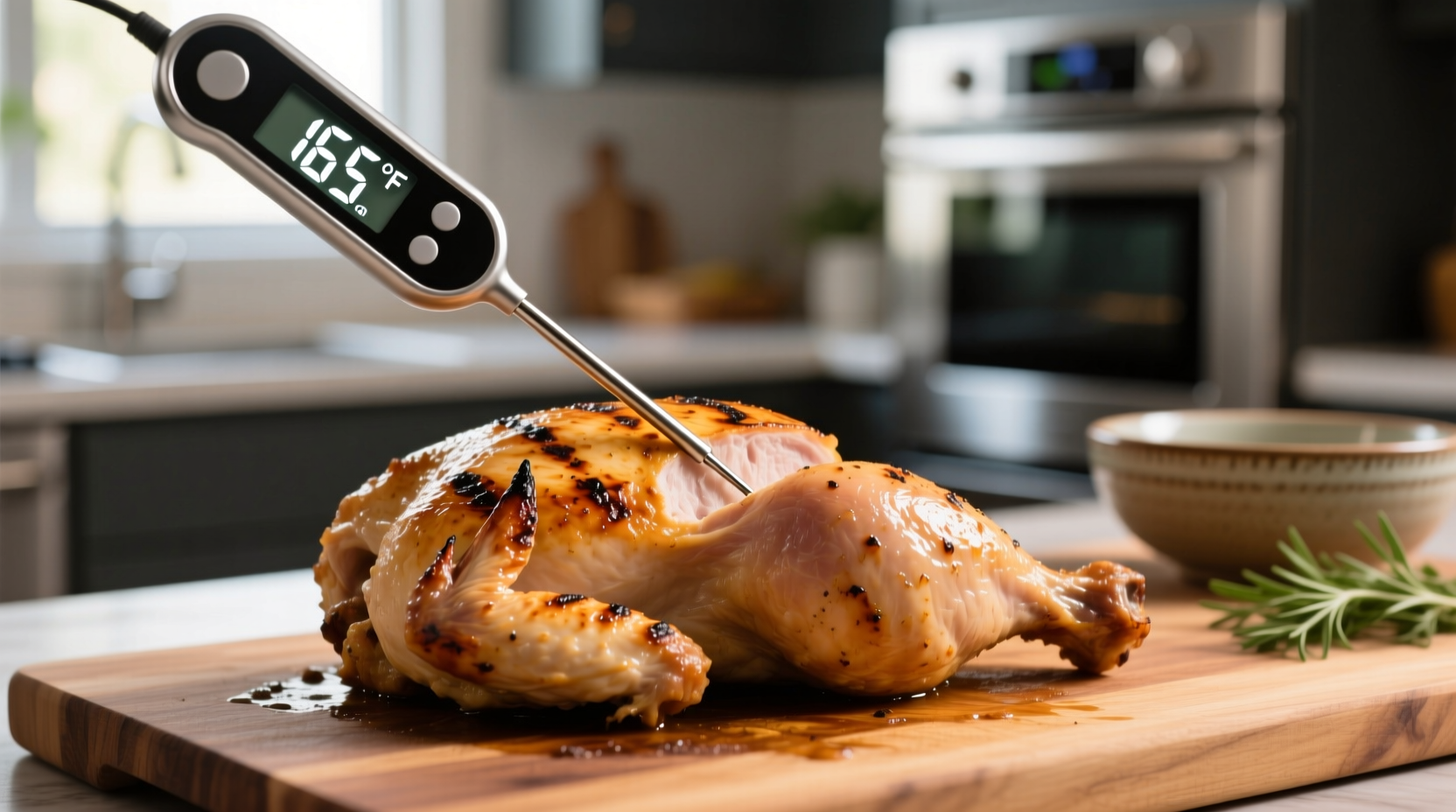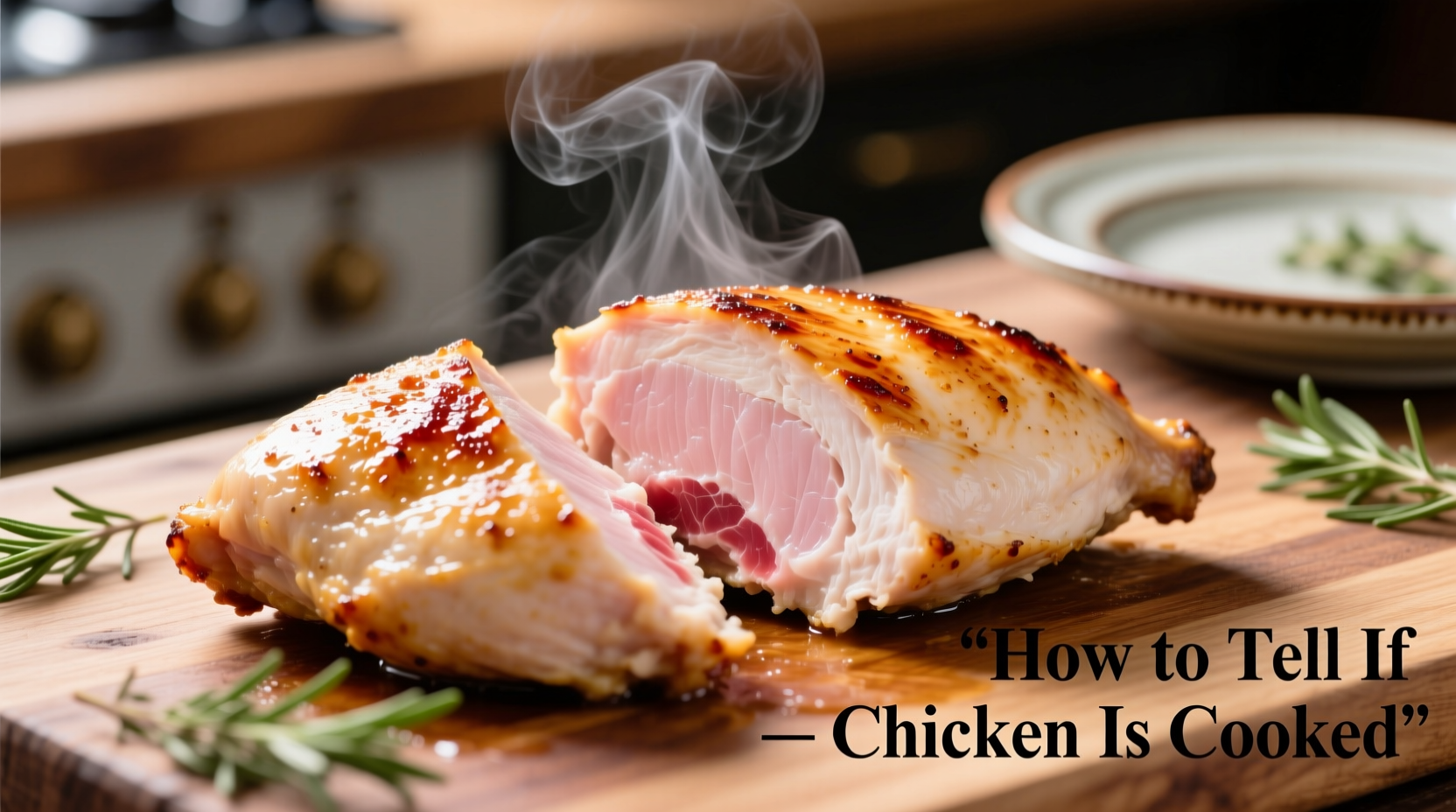The safest and most reliable way to tell if chicken is cooked is by using a food thermometer to confirm it has reached 165°F (73.9°C) internal temperature. Visual cues like clear juices and lack of pink color can be misleading, but when combined with proper thermometer use, they provide valuable confirmation that your chicken is safely cooked and ready to eat.
Ever pulled chicken off the grill only to cut into it and find it's still pink inside? Or worse—served undercooked chicken to guests without realizing it? Knowing exactly when chicken is properly cooked isn't just about taste—it's critical for food safety. In this guide, you'll learn the science-backed methods professional chefs and food safety experts use to determine chicken doneness with 100% confidence, so you can serve perfectly cooked, safe chicken every single time.
Why Thermometer Use Is Non-Negotiable for Chicken Safety
While many home cooks rely on visual cues alone, the USDA Food Safety and Inspection Service emphasizes that only a food thermometer provides definitive proof that chicken has reached a safe internal temperature of 165°F (73.9°C). This temperature destroys harmful bacteria like Salmonella and Campylobacter that can cause serious foodborne illness.
Here's what happens at the molecular level: when chicken reaches 165°F, the proteins denature completely, turning opaque and firm while eliminating pathogens. Lower temperatures may appear cooked but still harbor dangerous bacteria. According to the USDA's Food Safety and Inspection Service, undercooked poultry causes approximately 240,000 cases of foodborne illness annually in the United States alone.
Mastering Thermometer Technique: The Professional Standard
Using a thermometer correctly matters as much as using one at all. Follow these steps for accurate readings:
- Insert the probe into the thickest part of the meat, avoiding bone, fat, or gristle
- For whole chickens, check both breast and thigh areas (they cook at different rates)
- Wait 10-15 seconds for the reading to stabilize
- Sanitize the thermometer between readings
Digital instant-read thermometers provide the most accurate results in seconds. The FDA Food Code specifies that thermometers should be accurate to within ±2°F (±1.1°C) for food safety purposes. Calibrate your thermometer monthly using the ice water method (should read 32°F/0°C) or boiling water method (212°F/100°C at sea level).
Visual and Tactile Indicators: Helpful But Not Definitive
While thermometer use is essential, understanding visual and tactile cues provides valuable secondary confirmation. These indicators become more reliable when combined with proper temperature verification.
| Indicator | Properly Cooked Chicken | Undercooked Warning Signs |
|---|---|---|
| Juices | Clear or faint yellow | Pink or red tinged |
| Texture | Firm but yielding to pressure | Soft, spongy, or jelly-like |
| Color | White or tan throughout | Pink or red hues, especially near bones |
| Shrinkage | Noticeable reduction in size | Minimal shrinkage |
Important context: visual cues can be misleading. Certain cooking methods like smoking or sous vide can produce pink meat even when fully cooked due to myoglobin retention. Darker meat near bones may appear pink even at safe temperatures—this is normal and not an indicator of undercooking.
Common Mistakes That Lead to Undercooked Chicken
Even experienced cooks make these critical errors:
- Testing only one spot—chicken cooks unevenly, especially in bone-in cuts
- Relying solely on cooking time—factors like starting temperature and oven accuracy vary
- Not accounting for carryover cooking—chicken continues cooking 5-10°F after removal from heat
- Using dull knives for testing—creates larger openings that dry out the meat
Professional chefs always let chicken rest for 5-10 minutes after cooking. During this critical period, the internal temperature typically rises 5-10°F while juices redistribute, ensuring both safety and optimal texture. Skipping this step can lead to inaccurate temperature readings and dry chicken.
Different Cuts, Different Doneness Requirements
Not all chicken parts reach safe temperatures at the same rate. Understanding these differences prevents both undercooking and overcooking:
- Breasts: Cook fastest but dry out easily—remove at 160°F and let rest to 165°F
- Thighs and drumsticks: Can handle higher temperatures (up to 175°F) for more tender results
- Whole chicken: Thighs must reach 165°F before breasts are done
- Ground chicken: Requires 165°F throughout with no pink visible
For precise timing guidance, the National Chicken Council provides recommended cooking times based on weight and method. However, these should always be verified with a thermometer, as variables like oven calibration and starting temperature significantly impact actual cooking time.
Food Safety Implications You Can't Ignore
Undercooked chicken poses serious health risks. According to data from the Centers for Disease Control and Prevention, chicken is among the top sources of foodborne illness in the United States. Symptoms of Salmonella infection typically appear 6 hours to 6 days after consumption and can include diarrhea, fever, and abdominal cramps lasting 4-7 days.
Vulnerable populations—including children under 5, adults over 65, pregnant women, and immunocompromised individuals—face higher risks of severe complications from undercooked chicken. When cooking for these groups, extra vigilance with thermometer use is essential.

Practical Doneness Testing Methods for Every Kitchen
Whether you're camping without electricity or hosting a dinner party, these field-tested methods work:
- For outdoor cooking: Use a dial thermometer with a 2-3 inch probe for best accuracy
- When thermometer isn't available: Cut into thickest part—no pink and clear juices indicate doneness (but still verify with thermometer when possible)
- For quick verification: Press the meat—properly cooked chicken feels firm but yields slightly
- For whole birds: Wiggle the leg—if it moves freely in the joint, it's likely done
Remember that carryover cooking continues after removal from heat. Pull chicken off the heat source when it reaches 160°F for breasts or 162°F for dark meat to account for this temperature rise during resting.
Final Verification Checklist Before Serving
Before serving chicken, run through this quick safety checklist:
- Thermometer confirms 165°F in thickest part (multiple spots for larger cuts)
- Juices run clear when pierced
- Meat appears white/tan throughout with no pink areas
- Texture is firm but not tough
- Resting period of at least 5 minutes has been observed
When in doubt, measure again. It's far better to slightly overcook chicken than risk foodborne illness. With practice, these verification steps become second nature, giving you complete confidence in your chicken cooking results every time.
Can chicken be safe if it's still slightly pink?
Yes, chicken can appear slightly pink near bones or in darker meat areas even when it has reached the safe internal temperature of 165°F. This pink color comes from myoglobin reacting with air during cooking and doesn't indicate undercooking. Always verify with a thermometer rather than relying solely on color.
How long should chicken rest after cooking?
Chicken should rest for 5-10 minutes after cooking. During this time, the internal temperature continues to rise 5-10°F (carryover cooking), juices redistribute for better texture, and the meat becomes easier to carve. Resting time varies by size—small cuts need 5 minutes while whole chickens require 10-15 minutes.
What's the most common thermometer mistake home cooks make?
The most common thermometer mistake is checking only one spot in the chicken. Different parts cook at different rates, especially in bone-in cuts. Always check multiple locations—the thickest part of breasts, thighs, and near bones—to ensure all areas have reached 165°F. Also, many home cooks don't insert the thermometer deep enough into the meat's center.
Can you tell doneness by how the chicken feels?
Experienced cooks can get a general sense of doneness by touch, but this method isn't reliable for food safety. Properly cooked chicken should feel firm but yield slightly when pressed. Undercooked chicken feels soft and spongy, while overcooked chicken feels hard and dry. However, texture alone cannot confirm the 165°F internal temperature needed to destroy harmful bacteria, so always verify with a thermometer.
Why does my chicken thermometer sometimes give different readings?
Inconsistent thermometer readings usually occur because you're checking different parts of the chicken (some areas cook faster than others), the probe isn't reaching the center of the thickest part, or the thermometer needs calibration. Digital thermometers should be accurate to within ±2°F. Test your thermometer in ice water (should read 32°F/0°C) or boiling water (212°F/100°C at sea level) to verify accuracy, and insert it into the same spot multiple times to check consistency.











 浙公网安备
33010002000092号
浙公网安备
33010002000092号 浙B2-20120091-4
浙B2-20120091-4